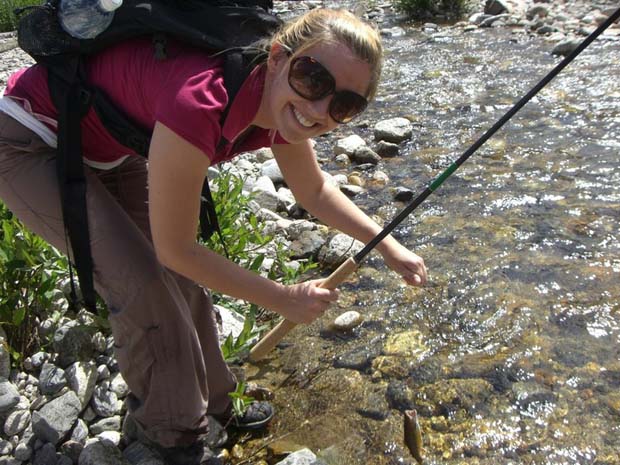Tenkara fly fishing wasn’t on the radar until recently. Tenkara USA, founded in April 2009 in San Francisco, started the ball rolling. Now it’s all the rage.
[highlight color=”yellow”]…[/highlight]Scroll down and watch how-to video featuring Yvon Chouinard, Craig Mathews, and Mauro Mazzo.
NOTE: Their book “Simple Fly Fishing: Techniques for Tenkara and Rod and Reel” reveals that modern-day fly fishing, like much in life, has become exceedingly complex, with high-tech gear, a confusing array of flies and terminal tackle, accompanied by high-priced fishing guides. The book shows that the best way to catch trout is simply, with a rod and a fly and not much else. The wisdom in this book comes from a simpler time, when the premise was: the more you know, the less you need.
About tenkara:
[dropcap]T[/dropcap]enkara fishing can be seen as a streamlined counterpart to western fly-fishing. The equipment is designed to direct focus to the actual fishing and catching of the fish, not to cause a major preoccupation with the equipment. Only a rod, tenkara line and fly are necessary for tenkara fishing (no reel is used).
The appeal of tenkara is its elegant simplicity. There are also other advantages of using the long tenkara rods when fishing in mountain streams, primarily the lightness of the line and delicate presentation. A long rod allows for precise placement of the fly on small pools and allows for holding the fly in place on the other side of a current. The other main advantage of using the long tenkara rod is precise control for manipulation of the fly.
Flyrod:
[highlight color=”yellow”]…[/highlight]: A very long and flexible rod (usually telescopic) is used in tenkara fishing. The rods normally range from 3.3 to 4.5 meters long (11 ft to 15 ft). These rods were originally made of bamboo, but are nowadays made with carbon and/or fiber glass. They also have a handle similar to fly-fishing rods that can be made of wood (the more prized rods) or cork.
Flyline:
[highlight color=”yellow”]…[/highlight]: As in fly-fishing, it is the tenkara line that propels the weightless fly forward. In tenkara, the traditional and most commonly used line is a tapered furled line (twisted monofilament), of the same length or slightly shorter than the rod. The main advantage of furled lines is the delicate presentation and ease of casting. Alternatively, a tenkara “level” line can be used. Level lines are specially formulated fluorocarbon adjusted to the desired length. They are easier to cast against the wind.
The traditional tenkara line has a loop of braided line at its thicker end. This braided line is used to tie the tenkara line directly to the tip of the rod by using a cow hitch (aka: girth hitch) knot. The line at the rod’s tip needs to have a stopper knot, which will hold the cow hitch in place. It is a very secure method to attach the line.
Tippet:
[highlight color=”yellow”]…[/highlight]: This is the same as a regular fly-fishing tippet, and is used to connect the fly to the line (which is too thick to tie directly to the fly). Usually between 30 cm to 1 meter of tippet is added to the end of the line. This is typically referred to in Japanese as “hea” (for hair).
Flies:
[highlight color=”yellow”]…[/highlight]Artificial flies are used in tenkara fly-fishing. These are tied with thread, feathers and sometimes fur as in western fly-fishing. Traditionally a special reverse hackle wet-fly is used. In Japan it is known as “kebari.” These traditional Japanese flies differ from most Western flies, in that the hackle is tied facing forward.
There are two new rods from Tenkara and each come in three different lengths-Sato and Rhodo- click here to view […]
To see traditional tenkara flies (“My Best Streams by Yoshikazu Fujioka”) click here […]
[youtube id=”AesUlGzaC0Q?rel=0″ width=”620″ height=”360″]


